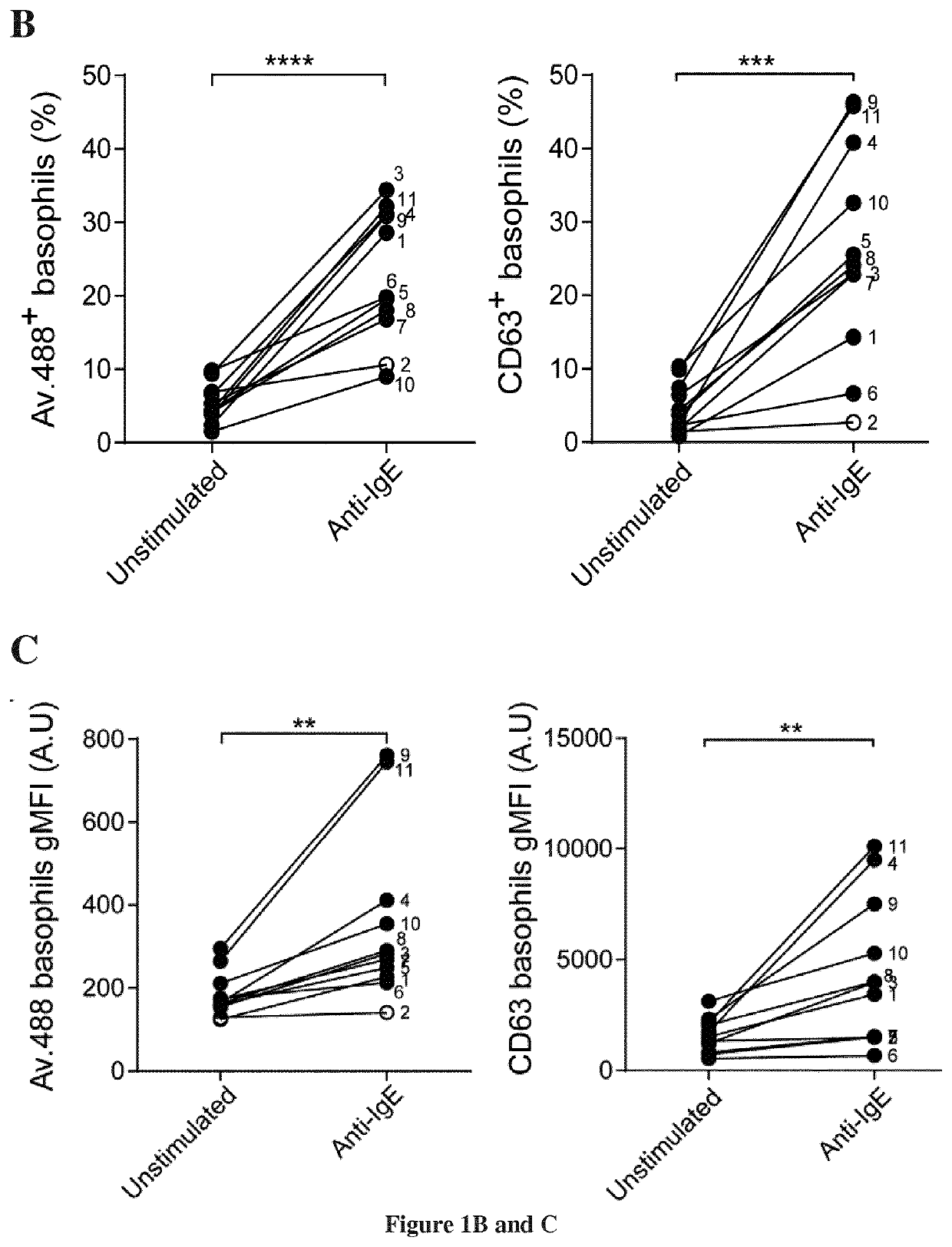Methods and kits for detecting basophil activation
a basophil activation and kit technology, applied in the field of methods and kits for detecting basophil activation, can solve the problem of not providing a direct measure of the granule exteriorization process, and achieve the effect of efficient specific basophil responses
- Summary
- Abstract
- Description
- Claims
- Application Information
AI Technical Summary
Benefits of technology
Problems solved by technology
Method used
Image
Examples
example 1
Material & Methods
[0066]Reagents. Primary antibodies used for immunostaining: anti-FcεRI efluor® 450 (clone AER-37, eBioscience), anti-CD203c BV510 (2.5 μL per test, clone NP4D6, BD Biosciences), anti-CD123 PE-Cy5 (clone 9F5, BD Biosciences), anti-CD16 Alexa 700 (clone 3G8, Beckman Coulter). Reagents used to stimulate peripheral blood cells were as follows: anti-IgE (clone MH25-1, Santa Cruz), PMA, phorbol 12-myristate 13-acetate and ionomycin (Sigma-Aldrich). Allergens extracts: bermuda grass (BAG-G2), orchard grass (BAG-G3), perennial rye grass (BAG-G5), timothy grass (BAG-G6), 6-grass mix (BAG-GX1: Orchard grass, perennial rye grass, Timothy grass, meadow fescue, meadow grass, velvet grass), ragweed mix (BAG-WX1: common ragweed, giant ragweed), all from Bühlmann laboratories and 5-grass mix (Alyostal: Phleum pretense, Dactylis glomerata, Anthoxanthum odoratum, Lolium perenne, Poa pratensis, Stallergenes). Avidin-Alexa 488 (Invitrogen) or anti-CD63 PE (clone H5C6 BD Biosciences) w...
example 2
)
Methods
Blood Specimens
[0078]Blood from randomly selected anonymous blood donors (allergy status unknown) was obtained from the Stanford Blood Center (Palo Alto, Calif., USA) and blood from 22 peanut allergic patients (Table 1) was obtained as part of their enrollment into two IRB-approved clinical trials (16 from POISED ClinicalTrials.gov Identifier: NCT02103270 and 6 from MAP-X ClinicalTrials.gov Identifier: NCT02643862). All blood samples were collected in heparin tubes and stored at 4° C. for 24 hours with gentle agitation before analysis (9). Peanut allergy was defined as having a clinical reaction to peanut during a double-blind, placebo-controlled food challenge to peanut (up to 500 mg total of peanut protein) and a positive skin prick test to peanut (>= to 5 mm).
TABLE 1Demographic characteristics of patients with peanut allergyAge (y)Range 4-26; median = 10, mean = 11Sex82% MaleEthnicity95% Not Hispanic / LatinoRace*68% Caucasian, 27% Asian and 5% multi-racial*Subjects self-id...
PUM
| Property | Measurement | Unit |
|---|---|---|
| concentration | aaaaa | aaaaa |
| concentration | aaaaa | aaaaa |
| concentration | aaaaa | aaaaa |
Abstract
Description
Claims
Application Information
 Login to View More
Login to View More - Generate Ideas
- Intellectual Property
- Life Sciences
- Materials
- Tech Scout
- Unparalleled Data Quality
- Higher Quality Content
- 60% Fewer Hallucinations
Browse by: Latest US Patents, China's latest patents, Technical Efficacy Thesaurus, Application Domain, Technology Topic, Popular Technical Reports.
© 2025 PatSnap. All rights reserved.Legal|Privacy policy|Modern Slavery Act Transparency Statement|Sitemap|About US| Contact US: help@patsnap.com



